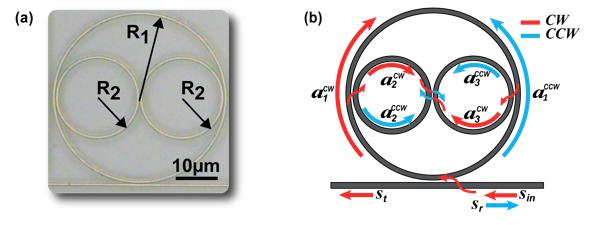Overview
The quantum mechanics is the adequate theory to describe the chemical bond between atoms which is responsible for the constitution of molecules and solids. In an atom the electrostatic potential between the nucleus and the electrons defines the discrete energy levels of the electronic states, in the case of an optical cavity the quantization of the optical frequencies arise from the multiple turns that the light performs in these cavities. Analogously to chemical molecules, which results from the hybridization of the electronic states between two neighbor atoms, the photonic molecules arises when two optical cavities are next to each other. The scale of proximity is typically the wavelength of the light and makes the microcavities an excellent “atom” to constitute molecules.
At LPD these molecules are designed and investigated from annular silicon microcavities, as illustrated on figure 1. The interaction between the microrings provokes a change on the transmission spectra of the cavities, these “tunable” specters of the photonic molecules have several applications in optical processing of optical signal processing.
Figure 1: (a) Microscopy of a photonic molecule formed by three ring microcavities. (b) Illustration of the eigenstates of this molecule and the possible coupling channels. [1-3].
References
[1] L. A. M. Barea, F. Vallini, P. F. Jarschel, and N. C. Frateschi. Silicon technology compatible photonic molecules for compact optical signal processing. Applied Physics Letters, 103(20):201102, Nov. 2013.
[2] J. Chan, T. P. M. Alegre, A. H. Safavi-Naeini, J. T. Hill, A. Krause, S. Gr ̈oblacher, M. Aspelmeyer, and O. J. Painter. Laser cooling of a nanomechanical oscillator into its quantum ground state. Nature, 478(7367):89–92, Oct. 2011.
[3] Q. Gu, J. Shane, F. Vallini, B. Wingad, J. S. T. Smalley, N. C. Frateschi, and Y. Fainman. Amorphous Al2O3 Shield for Thermal Management in Electrically Pumped Metallo-Dielectric Nanolasers. Quantum Electronics, IEEE Journal of, 50(7):499–509, July 2014.

